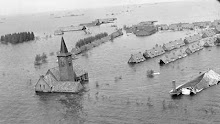>>Abroad at last!
English Channel: 15 Feb 1946
Life list now 162 species
“Sailed across from Newhaven A to Dieppe B 0620 to 1130"
View Larger Map
Did not sail from Dover so missed the opportunity to see a twitcher's delight, forecast in this song of 1942 [Bluebirds are unknown in England, though apparently the American song writer was unaware of that].>>>
"In the Channel, chiefly gulls to be seen. Near both shores, mainly Black-headed with one up to c 5 miles from France. Further out, principally Common with some Herring and a few Great Black-backed.
Several times, mostly on the E side, saw [Northern] Gannets* singly or in parties of up to 4. More Guillemots, up to 6 together, were identified. They seemed to be in two stages of plumage which I put down as summer and winter. Also seen were 2 or 3 Razorbills* and 1 [Atlantic] Puffin*. About 8+ miles east of Newhaven, 2 Starlings in flight (c. west) and another c. 5 miles from France. Skylarks on 3 or 4 occasions at different spots and one (domesticated?) pigeon circled the ship c 3 miles from Dieppe."
2 or 3 miles off Dieppe, a party of c. 15 ducks, just over half were Pintail, the rest Mallard. A lone duck with a very long tail and most "un-Pintail"-like appearance was seen a c. 5 miles from France, and another two with almost complete white underparts convinced me they were male Long-tailed Ducks*.
Left Dieppe by train at c 1850 for Toulon. On a small flooded pit just west of Dieppe were several waterfowl. About half (c. 40) seemed Coot, the others probably Tufted Ducks and/or Goldeneye as they were very pied. Wigeon also spotted in flight. Other birds seen from the train, 2 Magpies, several Rooks, c.80 Jackdaws and c. 80 Lapwings.
Weather: very calm and mild to cool, cloudy nearly all day but no precip.”
>>14 Feb 1946
By train to Newhaven on the south coast of England
The RAF does not tell you what its plans for you are! From Manchester A to Newhaven B was a good leap southwards and in front was the English Channel, presumably to be crossed next. >>>
View Larger Map
“In Newhaven harbour were Black-headed, Common and Herring Gulls. Near the harbour mouth in the sea and on the beach, 2 Common Guillemots. A probable male Pintail flew near there too.”
>>England, Heaton Park, Manchester:
4-13 Feb 1946
Still waiting with little to do, so I spent much of my time birdwatching.>>>
“Observed a very white Blackbird in shrubbery in the park on 4 Feb. I had little chance to view it closely but saw a greyish head (crown) and yellow bill. A friend (Roland Kern) with me said he saw "black tips". Identified it by typical note. Frequently looked round the reservoir in the Park and spotted Mallards, Tufted Ducks and Pochard as well as Black-headed, Herring and Common Gulls. Bodies of two of the latter were found with heads ripped off, probably by a Peregrine Falcon. On 11 Feb, visited Greenfield and walked on the moors. Only bird, Red Grouse.”
Subscribe to:
Post Comments (Atom)


No comments:
Post a Comment